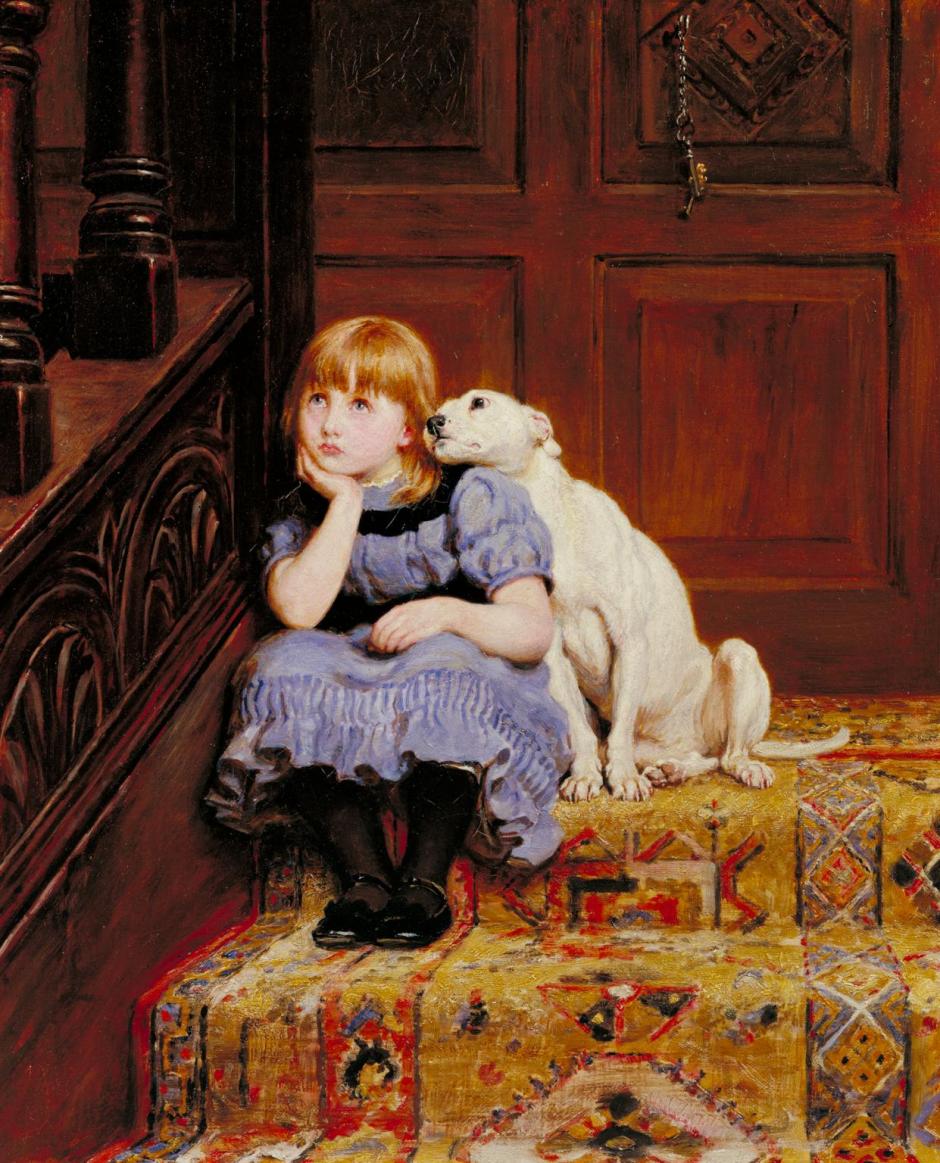On Monday, it will be exactly one century since the death of the highly popular Victorian animal painter Briton Rivière (1840-1920). In today’s and Monday’s articles, I show a selection of his paintings and trace his career.
Rivière, who had Huguenot ancestors, came from an artistic family. His father was drawing master at the prestigious Cheltenham College (actually a private school), and later in the University of Oxford. Briton followed his father in his own education, and was taught painting almost entirely by him. He seems to have been precocious, exhibiting three works at the Royal Academy when he was only sixteen.

By 1863, when he painted The Old Gardener, he was making a name for himself with these popular genre paintings. At this stage, animals were just another part of the whole scene, as is the small dog sat beside this old man as he dozes in his shed. A couple of years later, he developed animals, particularly dogs, as his major and enduring theme.

Rivière’s A Saint, from the ‘Jackdaw of Rheims’ from 1868 takes a literary theme, a poem titled The Jackdaw of Rheims by Richard Harris Barham (1788-1845), which was popular at the time. This tells of a jackdaw who sat on a cardinal’s chair in Rheims, and was made a saint as a result of the effect that he had on the humans around. Although his depictions of dogs and other domestic animals are very realistic, the bird here lacks a jackdaw’s pale hood and its bill is too long and heavy. It stands on a pile of books with a rosary by its foot.

He played on contemporary sentimentality with great success. The old man in The Long Sleep from 1868 may well have died quietly as he slept by the empty fireplace, and his faithful dogs are now trying to wake him up. On the floor in the right foreground are the fragments of a broken clay smoking pipe, and at the far left leaves are scattered, hints perhaps of his demise.

Pallas Athena and the Herdsman’s Dogs, which he completed and exhibited at the Royal Academy in 1876, is based on a section of Homer’s Odyssey Book 16. It was shown with the translated fragment
Then drew she nigh, in shape a stately dame,
Graced with all noble gifts of womanhood:
None save Odysseus saw her; for to few
Of mortal birth the gods reveal themselves.
But the dogs knew her coming, and with whine
And whimpering crouched aloof.
Athena appears to Odysseus when he finally arrives on his home island, when she is disguised as a herdsman. She tells the hero incorrectly that Penelope, his wife, has presumed him dead and already remarried. When he lies back to her, she reveals herself and gives him the information he needs to regain his wife and kingdom.

Most of his paintings were simpler and more direct, like Sympathy from about 1878. This shows a girl who has been sent to sit at the top of the stairs in disgrace, as her pet dog tries to comfort her. It struck the right spot with an adoring public, and the painting shown here is actually a study for a second version.

In Tick-Tick from 1881, he shows a puppy sat beside a ‘hunter’ pocket watch, fascinated by its rhythmic ticks.

Cupboard Love, from the same year, is a visual and verbal pun. The phrase refers to affection in return for gain, shown well in the two dogs whose interest lies in the food which the young woman is about to produce from the heavy wooden cupboard behind them.

I expect that Rivière was well aware of the contemporary paintings of Gérôme showing scenes of gladiatorial combat and martyrdom in classical Rome. This may have inspired his A Roman Holiday (1881), which shows a wounded Christian inscribing a cross in the sand as a tiger lies dead by him, and another snarls behind.
He was meticulous in his later animal painting, studying live animals at the zoo in Regent’s Park in London, where he also dissected them to examine their anatomy. At one time, he admitted to keeping the body of a lioness in his studio.
That same year, Rivière was elected a full academician.

His Giants at Play (1882) may have been influenced by the gradual transformation of social realism into the Naturalism of Jules Bastien-Lepage. It shows three labourers wearing tatty clothes and hobnail boots teasing a young puppy with some feathers tied to a piece of string. There is a more sinister side to this scene, though: the men were probably starting to train this dog to fight for their sport and gain when it was fully grown.

The Miracle of the Gaderene Swine (1883) is one of Rivière’s few Biblical paintings, and refers to a story in the three synoptic Gospels. In this, Jesus crossed to the east bank of the Jordan, where he met a man possessed by demons and exorcised them into a herd of pigs. The swine then rushed down a steep bank and were drowned in the Sea of Galilee below.

The Sheepstealer, from 1884, shows a rustler with his dog preparing to steal a flock of sheep, who are gathering and staring at the thief, blissfully unaware of what is about to happen to them.

